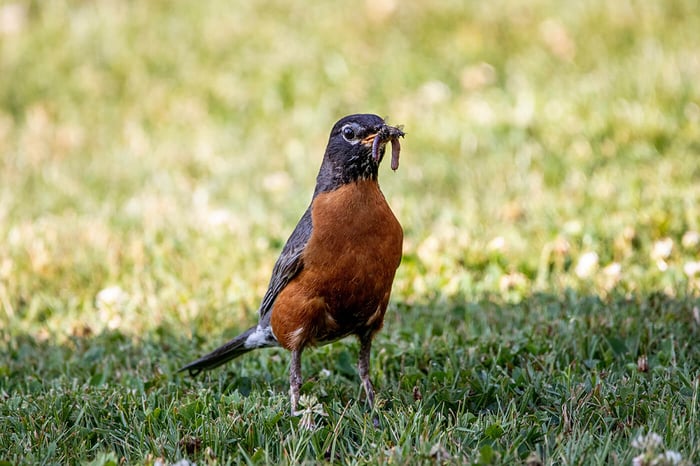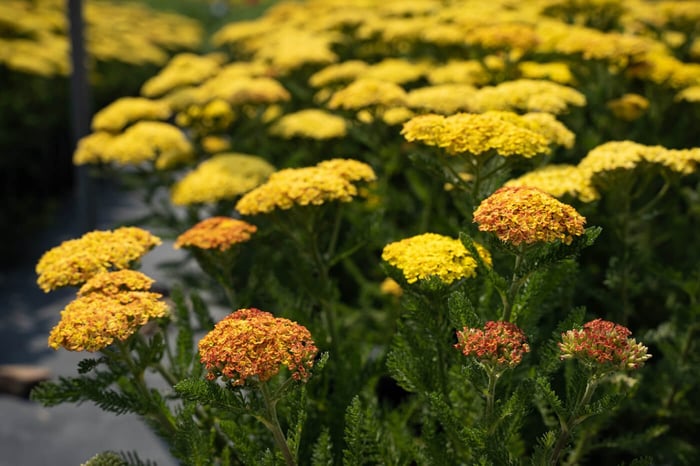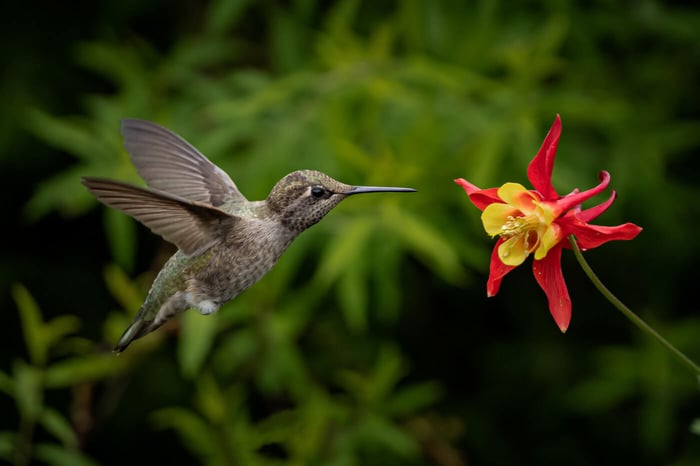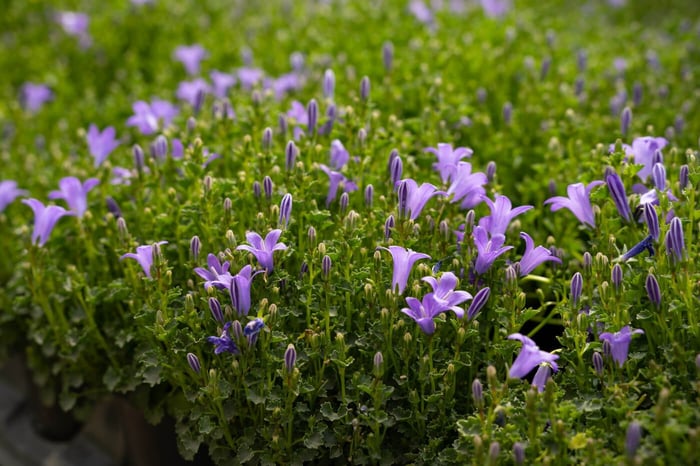Nesting birds are incredibly fun to have in your yard. They add life, sound, and entertainment to your landscape. You’ll enjoy watching the birds build their nests, feed their young, and introduce their little fledglings to the wide, wide world. The mere presence of birds in your landscape will make your yard feel much more like an escape to nature—a place where you can find rest and rejuvenation from your crazy schedule.

Nesting season extends beyond the spring.
When we think of nesting season, we think of spring, and for the majority of birds it is. But here in Utah, you may see birds nesting at various seasons throughout the year. It all corresponds with their food supply.
The breeding season is strenuous. Between competing for mates, producing eggs, guarding their nests, and feeding their young, birds need an ample supply of food to keep their energy up. Usually, that means nutrient-rich insects, so the nesting season is timed to coincide with the greatest abundance of insects. That’s why most birds in Utah nest in the spring and early summer.

But not all birds feed insects to their young. American Goldfinches and Lesser Goldfinches feed their young regurgitated seeds, so they need to nest in the summer when seed production is at its peak. Pinyon Jays nest in late fall and winter because their favorite food is pine nuts, which ripen late in the year. If they have enough food for their young, they’ll nest when the ground is covered in snow and again in late summer.
If you’re ready to invite more nesting birds into your landscape, you’ll need to create a natural habitat that they are used to; a place that helps provide for their needs. That’s a whole lot easier than it sounds—you just need to plant the right plants. Here are some of the most popular nesting birds and a list of plants that you can use to attract them to your yard.
Please Note:
We are listing the following plants because nesting birds appreciate them. This is by no means a complete list. If you click the images or links in this email and see that we don't have what you're looking for, it just means that the plants we're growing aren't ready yet. Keep checking so you can get yours when they're available.

Bluebirds
You’ll see two types of bluebirds in Utah, Western Bluebirds, and Mountain Bluebirds. They eat a diet of mostly insects, but they also eat berries now and then. Bluebirds nest in enclosed cavities just like nuthatches, House Wrens, European Starlings, House Sparrows, and swallows, so they can sometimes get bullied out of their nesting spot. Offering hollow places for nesting, or providing nesting boxes may help draw them into your yard. Plants to consider for bluebirds include:
Dogwood, Hawthorn, Oregon Grape, Sumac, Hackberry, Blackberries, honeysuckle, virginia creeper, and red cedars such as Taylor Juniper and arborvitae.
Striking variegated foliage with bright red twigs.
Thornless with glossy green foliage and bold fall color.
Lacy foliage, bold color, and persistent fruit.
Soft, blue-green foliage and a narrow, refined form.
Thick shrub with red new growth that turns dark green. Edible fruit.
Red blossoms turn orange and yellow as they open.

Wrens
Wrens eat insects and like to have secure places to hide and nest. You aren’t planting plants to feed wrens, but rather to attract the insects they eat and to provide cover and shelter for the birds. Tall grasses, dense trees, and thick shrubs offer security and also attract insects. Lady’s Mantle has been mentioned, specifically, as a plant that attracts wrens. Not only is it a stunning addition to your landscape, but it's also a dense, low-growing perennial where ground-feeding wrens will find bugs and insects.
Karley Rose Dwarf Fountain Grass
Graceful, spreading clumps of showy foliage
Dense fan-shaped foliage topped with prolific dainty, chartreuse, star-shaped flowers in late spring.
Columnar, heat and drought tolerant, yellow in fall.

Tree Swallows
Swallows are amazing birds that are often named after the places where they choose to build their nests—Cliff Swallows, Tree Swallows, and Barn Swallows, for instance. Barn swallows get a bad rap because they can make a mess of structures with their mud nests that they return to year after year. However, swallows are great birds to have around because they devour insects. Their streamlined bodies are designed for maneuverability in flight so they can catch bugs in the air.
As their name suggests, tree swallows build their nests in holes in dead or live trees, or in hollow stumps. Like other swallows, tree swallows eat mostly bugs and insects. However, they will also eat plant material from time to time, especially in the winter, when insects are scarce. Plants that may attract tree swallows, either for their fruit or for the insects that rely on them, include:
Serviceberry shrubs or trees, redbud trees, catmint, Bee Balm, and bottlebrush buckeye.
Autumn Brilliance Serviceberry
Irregularly-oval shaped small tree, white flowers, delicious fruit.
Ruby Falls Weeping Eastern Redbud
Weeping tree with a twisting growth habit, maroon leaves, and stunning lavender blooms.
Long-blooming selection, ideal for small spaces, indigo blue flowers cover the whole stem.

Bee-You 'Bee Merry' Bee Balm (Monarda)
Mildew free, covered in beautiful deep rosy-coral flowers in summer.

Chickadees
If you have a bird feeder, you’ll eventually see chickadees eating from it. But you can draw them into your yard with plants just as easily. Chickadees prefer the trees that support the greatest number of caterpillars: oak, native cherries, birch, and willows. They also like sumac and other dense shrubs for protection, and they love to eat the seeds of aster, goldenrod, coneflowers, and sunflowers.
This columnar oak resists mildew and has matte green foliage that turns yellow.
Low, wide-spreading shrub with amazing red and orange fall foliage.
Bright green foliage turns purple, fragrant flower clusters, deep red fruit.
Fall Aster
A full, bushy mound of finely textured foliage engulfed in sapphire blue flowers.
A compact form with a splash of showy flower spikes in summer.
A delightful display of unpredictable colors from July through September.

Tufted Titmouse and Nuthatches
Nuthatches and tufted titmouse have similar needs. They both devour insects, bugs, spiders, and caterpillars. (A tufted Titmouse will also eat snails now and again.) These helpful feathered friends eat seeds, suet, and other plant material when insects are hard to find. You can help them out by planting elderberries, eastern white pine, maple, beech, birch, and oak trees.
Foliage changes from purple and pink, to bronze-green with pink, to bronze-gold.
Laced Up Columnar Black Elderberry
This narrow elderberry can reach up to 10 feet tall, but only 3 feet wide.
Upright, Eastern White Pine with soft, attractive golden-green foliage.

Robins
Robins have a very broad diet. They love beetles, worms, and insects as well as fruit, seeds, suet, and sunflowers. Robins are among the earliest birds to return in the spring when food sources are low. You can help provide for them by planting plants that develop fruit or berries. It's even better if they have access to winter berries or persistent fruit. Excellent food sources for robins include: crabapples, chokecherry, hawthorn, and certain dogwoods.
Excellent, disease-free, pyramidal tree. Fuchsia-red spring flowers are followed by persistent cherry-red fruits.
This multi-stemmed shrub features blood-red stems in winter. White flower clusters bear white berries.

Goldfinches
Goldfinches add a bright flash of yellow to your garden in the late summer and fall as they eat seeds while balancing on flower stems, hardly bending them. You’ll love watching them in your yard. Their favorite food plants include:
Asters, coneflowers, sunflowers, coreopsis, thistles, goldenrod, elderberries, and bachelor buttons (cornflowers).
Other nesting finches, such as house finches, are drawn to dense trees and shrubs, such as spruce trees, because they provide a secure place for nests.
Supreme 'Cantaloupe' Coneflower
Color of a ripe cantaloupe. Young flowers look like a double Gerbera daisy
'Hoopsii' Colorado Blue Spruce
This large evergreen conifer with extremely blue foliage develops a pyramidal shape at maturity.
'Jethro Tull' Coreopsis Tickseed
New hybrid coreopsis with fluted, golden yellow petals and a compact habit.

Western Scrub Jays and Pinyon Jays
In some small pockets of Utah, you may see a Blue Jay, but the most common jays in this area are Western Scrub Jays and Pinyon Jays. Western Scrub Jays like acorns and are known as the oak tree planters of the bird family. Pinyon Jays like pine nuts, especially pinyon (sometimes spelled piñon) pine nuts. Both birds supplement their diet with seeds of other plants, berries, small fruits, nuts, or grain. In the summer they’ll eat insects, including beetles, caterpillars, and grasshoppers. And sometimes they’ll even eat small animals, including the eggs and young of smaller birds.
Scrub Jays nest early in the year, from March to April, feeding their young on insects. Pinyon Jays nest in late winter, feeding their young on stored pinyon seeds and other pine nuts.
If you want to improve your chances of seeing these jays in your yard, plant oak and beech trees as well as pinyon pine and other large conifer trees. They’ll also eat berries such as serviceberries, elderberries, cherries, wild grapes, blackberries, and persistent fruits such as crabapples.
Colorful purple-pink foliage catches the light in spring. Foliage changes to bronze-green with pink and white edges in summer.
Slow-growing evergreen with edible pine-nut. More drought and wind tolerant than most pines. Utah native.
































